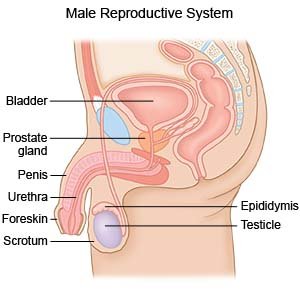Laser Prostatectomy
Medically reviewed by Drugs.com. Last updated on Aug 4, 2025.
WHAT YOU NEED TO KNOW:
Laser prostatectomy is surgery that uses a laser light beam to destroy part of the prostate gland. This can help reduce urinary problems caused by an enlarged prostate.
 |
HOW TO PREPARE:
The week before your surgery:
- Arrange to have someone drive you home after surgery and stay with you for 24 hours.
- Tell your surgeon about all medicines you currently take. He or she will tell you if you need to stop any medicine before surgery, and when to stop. He or she will tell you which medicines to take or not take on the day of surgery.
- You may need blood or urine tests before your surgery. You may also need x-rays, an EKG, ultrasound, cytoscopy, or prostate biopsy.
The night before your surgery:
- You may be told not to eat or drink anything after midnight.
- You may be given medicine or an enema that will empty your bowel.
The day of your surgery:
- You or a close family member will be asked to sign a legal document called a consent form. It gives healthcare providers permission to do the procedure or surgery. It also explains the problems that may happen, and your choices. Make sure all your questions are answered before you sign this form.
- Take only the medicines your surgeon told you to take.
- An IV will be placed into a vein. You may be given liquids or medicine through the IV.
- You may be given general anesthesia to keep you asleep and free from pain during surgery. Spinal anesthesia may instead be injected into your spine to keep you numb below the waist. You you may feel pressure or pushing during surgery, but you should not feel pain.
WHAT WILL HAPPEN:
What will happen:
- Your surgeon will insert a scope into your penis through your urethra. He or she will use the scope to find the narrowed part of your urethra that the prostate blocks. He or she will make an incision in the urethra to reach the prostate.
- Your surgeon will use a laser to destroy excess prostate tissue. He or she may remove a part of your prostate and pass it into your bladder. It will then be broken into tiny pieces. The pieces will be removed or left in your bladder to be passed out in your urine.
- Your surgeon may also use the laser to seal blood vessels and stop any bleeding. He or she will place a urinary catheter to help drain your urine.
After your surgery:
You will be taken to a room to rest until you are fully awake. Healthcare providers will monitor you closely for any problems. Do not get out of bed until your healthcare provider says it is okay. When your healthcare provider sees that you are okay, you may be able to go home.
CONTACT YOUR HEALTHCARE PROVIDER IF:
- You have a fever.
- You have questions or concerns about your surgery.
Seek Care Immediately if
- You cannot urinate, or if you have a catheter, no urine is filling the bag.
- You have lower abdominal pain or back pain that does not go away.
- Your urine is red, cloudy, and foul smelling.
Risks
The laser may irritate or damage the tissue in and around your prostate. Nerves or blood vessels may be damaged, which may lead to problems urinating or having an erection. Your surgeon may need to make a larger incision than expected during surgery. Even with surgery, your prostate may become enlarged again and you may have problems urinating.
Related medications
Care Agreement
You have the right to help plan your care. Learn about your health condition and how it may be treated. Discuss treatment options with your healthcare providers to decide what care you want to receive. You always have the right to refuse treatment.© Copyright Merative 2025 Information is for End User's use only and may not be sold, redistributed or otherwise used for commercial purposes.
The above information is an educational aid only. It is not intended as medical advice for individual conditions or treatments. Talk to your doctor, nurse or pharmacist before following any medical regimen to see if it is safe and effective for you.
Further information
Always consult your healthcare provider to ensure the information displayed on this page applies to your personal circumstances.
